

TEXT: Teaching problem solving: Let students get ‘stuck’ and ‘unstuck’ In the real world, students encounter problems that are complex, not well defined, and lack a clear solution and approach.
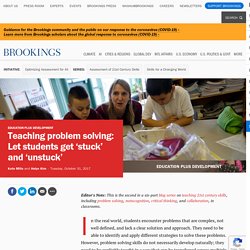
They need to be able to identify and apply different strategies to solve these problems. However, problem solving skills do not necessarily develop naturally; they need to be explicitly taught in a way that can be transferred across multiple settings and contexts. Here’s what Kate Mills, who taught 4th grade for 10 years at Knollwood School in New Jersey and is now a Literacy Interventionist at Red Bank Primary School, has to say about creating a classroom culture of problem solvers: Helping my students grow to be people who will be successful outside of the classroom is equally as important as teaching the curriculum.
TEXT: Integrating How-To Videos to Empower Student Learning. As adults, we often rely on people with practical knowledge to model procedures for certain tasks we intend to do on our own.
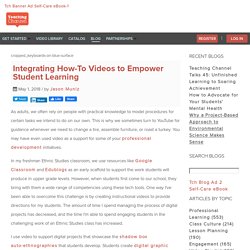
This is why we sometimes turn to YouTube for guidance whenever we need to change a tire, assemble furniture, or roast a turkey. You may have even used video as a support for some of your professional development initiatives. TEXT: Why Struggle Is Essential for the Brain — and Our Lives. As parents and teachers, we do just about everything we can to make sure that children don’t struggle.
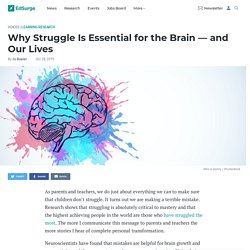
It turns out we are making a terrible mistake. Research shows that struggling is absolutely critical to mastery and that the highest achieving people in the world are those who have struggled the most. The more I communicate this message to parents and teachers the more stories I hear of complete personal transformation. TEXT: Changing Your Instructional Mindset. Dylan O’Connor, Nyree Smith, and Tobi E.
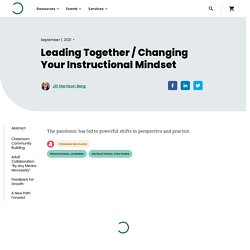
Afolayan are teacher leaders at the Lilla G. Frederick Pilot Middle School in Boston. Listen & Learn. TEXT: The Critical 21st Century Skills Every Student Needs and Why. Preparing a child for the world that doesn’t yet exist is not an easy task for any teacher.

Step back and look at that picture from a broad perspective. What are the critical 21st century skills every student needs to survive and succeed in our world? What abilities and traits will serve them in a time that’s changing and developing so rapidly? No pupil in the history of education is like today’s modern learner. TEXT: The Real Keys to Critical Thinking. VIDEO: Productive Struggle: 5 studies. VIDEO: LearnStorm Growth Mindset: Dave Paunesku on teacher modeling of growth mindset.
VIDEO: John Dewey’s 4 Principles of Education Today. VIDEO: Growth Mindset vs. Fixed Mindset. TEXT: Making The Shift from Student Engagement to Student Empowerment - John Spencer. Understood - For learning and thinking differences. Social and emotional skills can be taught to students of all ages.
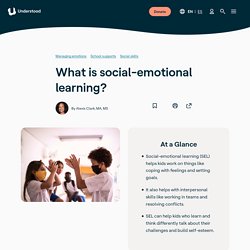
The younger kids are when they start learning how to build these skills, the better. But research shows that working on them during adolescence can also help. TEXT: Social-Emotional Learning (SEL) Activities for Middle School. 4.
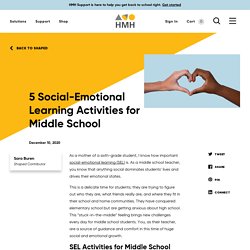
Responsible Decision-Making Educators often help teach students to make good choices and behave ethically. Assigning a writing prompt is a great way to get students thinking about their actions and social norms, along with the well-being of others. Understood - For learning and thinking differences. TEXT: Ethics Alive! Cultural Competence, Awareness, Sensitivity, Humility, and Responsiveness: What's the Difference? By Allan Barsky, J.D., MSW, Ph.D.

When the NASW Code of Ethics was revised (effective January 1, 2018), one change was to the title of Standard 1.05. The original title for this standard was “Cultural Competence and Social Diversity.” The revised title is “Cultural Awareness and Social Diversity.” So, one might ask, what is the import of this particular change in wording?
When speaking or writing about issues related to culture and social diversity, different social workers have favored different terms: cultural competence, cultural awareness, cultural sensitivity, cultural humility, and cultural responsiveness. TEXT: 8 Ways to Embed SEL within Academic Content. Although the term social emotional learning has been around for over 25 years, SEL has recently gained momentum as more and more educators see the immense need for supporting it within both adults and students.

My own knowledge has grown, too, after several collaborative conversations with colleagues, Carrie Edmond and Rebekah Kmieciak, and making time to create practice out of research. At a professional development that I led last year, I used an optimistic closure strategy from CASEL called “One Minute Accolade” to reflect on our time together. One teacher commented during our debrief that she used to think SEL was just fluffy stuff, but now knows it can enhance both the social-emotional and the academic learning.
This powerful comment has stayed with me ever since and as I continue to research and apply, I find it inspiring to continue to develop ways to help teachers connect SEL to their content. TEXT: How to Foster Independence in the Early Elementary Grades. As educators, we’ve all been there—pressed for time, trying our hardest to stick to a tight schedule.
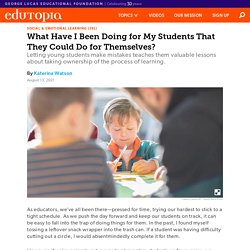
As we push the day forward and keep our students on track, it can be easy to fall into the trap of doing things for them. In the past, I found myself tossing a leftover snack wrapper into the trash can. If a student was having difficulty cutting out a circle, I would absentmindedly complete it for them. TEXT: How Student Voice Transformed East High. Young people, increasingly, are leading protests and engaging in advocacy for their generation and their communities. Think of the March for Our Lives, organized by students who survived the Parkland school shooting, or Greta Thunberg, the 16-year-old climate activist who started a worldwide movement to demand policy change (and was named Time's 2019 Person of the Year).
On the world stage, youth are using their voices to effect change. VIDEO: Using Dialogue Circles to Support Classroom Management. VIDEO: Building Emotional Literacy in Preschoolers. TEXT: Personal Development. TEXT: Strengths-Based Teaching is About Starting with the Known. “All children are ready to learn something, but each starts their learning from a different place. Teachers must find out what children already know, and prepare to take them from where they are to somewhere else.” (Clay, 2016, p. 27) Recently, my mother-in-law had a mild stroke. Because of this, she was required to take a driving exam in order to maintain her license. Having not been in that situation for more than 50 years, she approached that task feeling extremely nervous and apprehensive, concerned about what she would and wouldn’t remember, and carrying the weight of the most pressing possibility: What if she failed and could no longer drive? TEXT: Teaching Styles In Physical Education.
It is important to highlight that there is not a preferred teaching style, nor are lessons taught entirely with one teaching style [7, 8]. Rather, it is encouraged that teachers use a range of approaches in their lesson and unit plans, as one particular style may best suit particular tasks. For example, a command style may be deemed safest and best practice for teaching students how to throw a javelin. Whereas, a guided discovery approach may be more advantageous if the learning objective is to develop social skills [2]. TEXT: Approaches to Serving Diverse Populations. VIDEO: Learning Styles. VIDEO: Using Technologies to Support Diverse Learning Needs. VIDEO: Differentiating Instruction: It’s Not as Hard as You Think. VIDEO: What Learning Style Are You? And Why It Doesn't Matter!
VIDEO: What is Problem-Based Learning? VIDEO: What is Inquiry-Based Learning? TEXT: Planning for Fair Group Work. Group work has a lot going for it. It incorporates the social-cognitive and social-emotional aspects of learning and can lead to memorable, engaging lessons and increased learning for students (Forsell, Forslund Frykedal, & Hammar Chiriac, 2020; Fung, Hung, & Lui, 2018). But group work can also fall flat—and cause student disengagement—if not carefully designed and assessed. The original cooperative learning movement, energized in the 1970s, emphasized that group work must be designed to feature positive interdependence (each student's work depends on the others' work) and individual accountability (individual learning is measured and reported)—methods found to increase student achievement. TEXT: Checking for understanding digitally during content area learning. TEXT: A Beginner's Guide to Flipped Classroom.
The Flipped Classroom is a blended learning model in which traditional ideas about classroom activities and homework are reversed, or "flipped. " In this model, instructors have students interact with new material for homework first. They then use class time to discuss the new information and put those ideas into practice. TEXT: What Is a Flipped Classroom? And What Are Its Learning Benefits? TEXT: Creativity in the Classroom. VIDEO: How to Model a Risk-Taking Mindset. VIDEO: What is Creative Learning? VIDEO: Simon Sinek on How Teachers Change the Culture & Climate of Schools. VIDEO: Teaching Grit Cultivates Resilience and Perseverance. VIDEO: How to Teach an Inductive Learning Lesson.